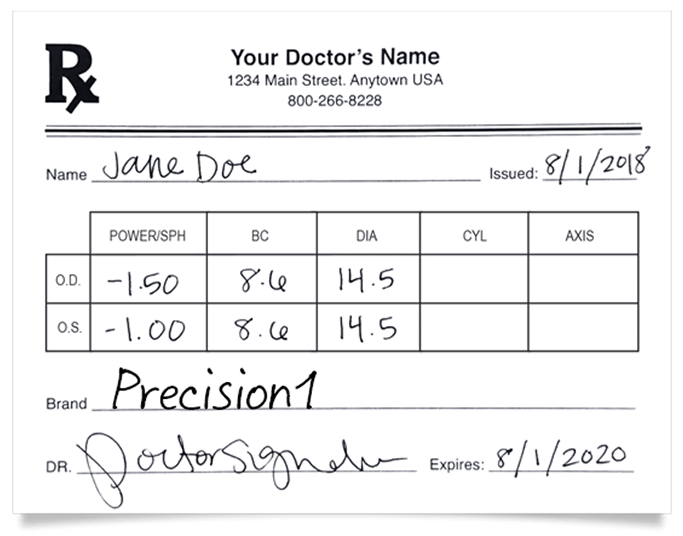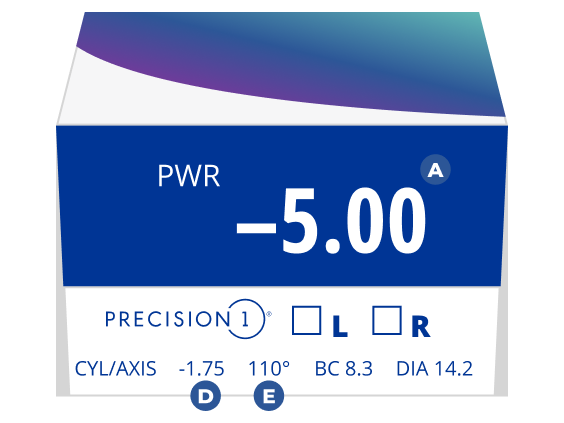Contact Lens Prescription 101
Reading your contact lens prescription only looks complicated. It’s actually really simple. No, really!
Let’s break it down.
Contact Lens Prescription 101
Reading your contact lens prescription only looks complicated. It’s actually really simple. No, really!
Let’s break it down.
How to Read a Contact Lens Prescription

All You need to know are these 3 numbers and abbreviations:
APWR: contact lens power is the amount of visual correction your contact lens provides, which may be different for each eye. This is indicated with a + or – depending on whether you are far- or nearsighted.
BDIA: contact lens diameter determines the width of your contact lens.
CBC: contact lens base curve determines what size the contact lens should be to fit the curvature of your eye.

If you have a contact lens prescription for astigmatism, there are a few additional numbers to look out for:
DCylinder: contact lens cylinder shows the extra correction needed for astigmatism with contact lenses (always a minus [–] on contact lenses).
EAxis: contact lens axis is a number between 0 – 180 degrees which shows the angle of correction needed for you to see clearly.
Or just have your eye doctor fill in the “left eye” or “right eye” checkbox on the side of each contact lens box, and move on with your day.

Everything You Need to Know and More About Contact Lens Prescriptions
Yes. Make an appointment with your eye doctor and register for a FREE* 5-day trial today.
No. In order to buy contact lenses, U.S. law requires you to have a valid contact lens prescription from a qualified eye doctor.
So give yours a call and set up an exam. Oh, and ask if they have PRECISION® contact lenses by name.
In most states, you’ve got one year to use ‘em or lose ‘em. If your prescription expires, you won’t be able to buy more lenses until your eye doctor provides a new one.
No. Contact lens prescriptions are different from eyeglass prescriptions. If you have eyeglasses but are interested in trying contact lenses, schedule an exam with your eye doctor.
Contact lenses that correct an astigmatism are called toric lenses. They contain two powers — one that corrects astigmatism, and another that corrects either nearsightedness or farsightedness. The magic happens when the two prescriptions sit perfectly where you need them to on your eye, without shifting around. PRECISION1® for Astigmatism and PRECISION7® for Astigmatism are uniquely designed to keep your contact lenses in place so you always have outstanding vision.
PRECISION® contact lenses can correct nearsightedness, farsightedness and astigmatism.
Get a Rebate** on Your Contact Lens Purchase
Get exclusive rebates on your purchase of Alcon contact lenses. Enjoy 16 hours of outstanding comfort and precise vision while saving money—because your eye care should be as affordable as it is effective.
**ask your eye doctor about rebates and instant savings that might be available
Get a Rebate** on Your Contact Lens Purchase
Get exclusive rebates on your purchase of Alcon contact lenses. Enjoy precise vision and dependable comfort while saving money—because your eye care should be as affordable as it is effective.
*Eye exam may be required before lens trial. Professional fees may apply. Offer available at participating offices.

IMPORTANT INFORMATION FOR PRODUCT PRECISION7® (SERAFILCON A) AND PRECISION7® (SERAFILCON A) FOR ASTIGMATISM CONTACT LENSES:
For daily wear or extended wear up to 6 nights for near/far-sightedness. Risk of serious eye problems (i.e., corneal ulcer) is greater for extended wear. In rare cases, loss of vision may result. Side effects like discomfort, mild burning or stinging may occur.
Ask your eye care professional for complete wear, care and safety information. 
